It’s Time for Medicare Annual Enrollment: Help Your Clients Get Ready for 2023
NASW Practice Alert | November 2022
Download as a PDF
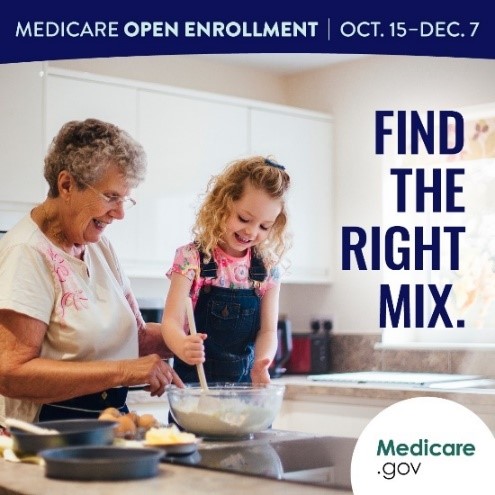
The Medicare annual election period, also known as the open enrollment period (OEP), opened on October 15 and ends on December 7. During this time, people who are already enrolled in Medicare can review, compare, and change their coverage options. Changes made during the 2022 OEP affect coverage between January 1 and December 31, 2023.
The Medicare OEP differs from the initial enrollment period for people newly eligible for Medicare. It is also distinct from Health Insurance Marketplace Open Enrollment, which occurs November 1 through December 15. (Learn about the relationship between the marketplace and Medicare.)
This Practice Alert addresses the following topics:
- profile of Medicare beneficiaries and the significance of annual enrollment
- overview of Medicare coverage options
- allowable changes during the Medicare OEP
- ways in which social workers can help clients during the Medicare OEP
- beneficiary out-of-pocket (OOP) costs associated with various types of Medicare coverage
- reduced-cost insulin and free vaccines as a result of the Inflation Reduction Act of 2022 (Pub. L. 117-169)
- Medicare OEP tools and resources, including detailed information about navigating Medicare Plan Finder
- financial assistance for Medicare beneficiaries
- messaging regarding Medicare Advantage (MA) and original Medicare
Medicare Beneficiary Profile and Importance of Annual Enrollment
As of July 2022, more than 64.8 million people in the United States were enrolled in Medicare, nearly 1 million more than had been enrolled in 2021. Medicare beneficiaries span a wide age range, with about 12 percent younger than 65 years and 88 percent 65 years or older. Thirteen percent (or nearly 7.5 million) lived below the poverty line in 2021—a figure that would be much higher if Medicare were not effective in reducing poverty among older adults. (Across beneficiary income levels, however, OOP health care costs have increased over the past 20 years.) Moreover, nearly 18 percent of Medicare beneficiaries were dually enrolled in Medicaid in 2020; these beneficiaries are commonly known as “dually eligible beneficiaries.”
These data convey the centrality of Medicare to the economic security and health of people with disabilities and older adults. The type(s) of coverage selected by beneficiaries can have profound effects on access to and cost of health care. Yet, navigating Medicare annual enrollment can be challenging even for long-time beneficiaries and experienced care partners.
CMS encourages beneficiaries to review coverage options each year because the needs of each beneficiary and the coverage available change frequently. However, an independent analysis found that during the 2021 OEP, seven of 10 beneficiaries did not compare their coverage options. Moreover, the analysis determined that this share was even higher among four groups of beneficiaries: (1) people with an annual income of less than $10,000 (or, to a lesser degree, $20,000), (2) beneficiaries who identified as Hispanic (or, to a lesser degree, those who identified as Black), (3) individuals younger than 65 or older than 84, and (4) dually eligible beneficiaries.
Overview of Medicare Coverage Options
Multiple Medicare coverage options exist. Most beneficiaries are enrolled either in original Medicare or MA:
- Original Medicare, also known as traditional Medicare, includes Part A (commonly known as hospital or inpatient insurance) and Part B (commonly known as medical or outpatient insurance). Original Medicare covers health care costs on a fee-for-service basis, meaning that payment is rendered to health care providers for each service billed.
- MA is a privatized form of Medicare. Multiple insurance companies, also known as plan sponsors, contract with the Centers for Medicare & Medicaid Services (CMS) to provide benefits covered by Part A and Part B in a “Medicare health plan,” or Part C. Each MA plan sponsor receives a fixed dollar amount per beneficiary to provide Medicare benefits in a given year; therefore, plan sponsors commonly employ utilization management and cost containment tools, such as prior authorization, that are not typically used in original Medicare. Plans may also charge copayments for services such as home health care, which is provided at no cost to beneficiaries in original Medicare. Given variations in plan costs (both short-term and long-term), services, quality, and provider networks, selection of an MA plan requires particularly careful consideration—a topic addressed further within the last section of this Practice Alert.
Some Medicare beneficiaries (primary dually enrolled beneficiaries) are enrolled in the Program of All-inclusive Care of the Elderly (PACE) rather than in original Medicare or MA. The purpose of PACE is to enable Medicare and Medicaid beneficiaries who qualify for a nursing home level of care (as certified by their state or jurisdiction) to live in home or community settings. PACE covers all Medicare- and Medicaid-covered care and services (including prescription drugs) and other services, including social services, deemed necessary by the PACE team to maintain and improve a beneficiary’s health. Individuals enrolled in PACE must be at least 55 years of age. PACE availability depends on organizational interest and CMS approval. Qualified individuals will be able to access PACE in 32 states in 2023.
Many beneficiaries who choose original Medicare also enroll in a Part D prescription drug plan. Most MA plans offer prescription drug coverage. If an MA plan does not offer prescription drug coverage, a beneficiary may enroll in a separate Part D plan, just as an original Medicare beneficiary would.
Many beneficiaries enrolled in original Medicare are also enrolled in a Medicare Supplement Insurance, or Medigap, plan. All 50 states, the District of Columbia, and Puerto Rico offer Medigap plans; such plans are not available in American Samoa, Guam, the Marshall Islands, and the Northern Mariana Islands. Ten types of Medigap plans exist, each identified with a letter: A, B, C, D, F, G, K, L, M, and N. (Plan J remains available to beneficiaries who enrolled in the plan before June 1, 2010, but is no longer available to new enrollees.)
- Private insurance companies may sell Medigap policies only to people enrolled in Medicare Part A and Part B; federal law prohibits sales of Medigap policies to MA enrollees unless the enrollee is switching back to original Medicare. However, Medigap plan and policy availability vary by location and insurance company, respectively:
- Each state, the District of Columbia, and Puerto Rico determines which types of plans may be offered. For example, one state may offer all 10 types of plans, whereas another may offer only three. The most widely available Medigap plan is Plan A, followed by Plan C or Plan F.
- Each insurance company determines which policies it offers and in which states. For example, a company may offer policies for two types of plans in one state and four in another. A company does not have to offer policies for every type of plan available in that state (or in Puerto Rico or the District of Columbia).
- Each Medigap policy within a specific plan type must offer the same basic benefits, as outlined by CMS. For example, a Plan K policy sold by Company 1 in Nebraska must offer the same basic benefits as a Plan K policy sold by Company 2 in Maine. Companies may also offer additional benefits within a policy for a given plan. Cost comparison is essential because different companies may charge different amounts for policies of the same plan type in the same state, even if none of the policies offers additional benefits.
The previous content regarding the 10 standardized Medigap plans does not apply to Massachusetts, Minnesota, and Wisconsin. Each of these states authorizes its own standardized plans.
The timing of enrolling in a Medigap plan for the first time or switching Medigap plans is important because federal guaranteed issue rights are only available at certain times in a Medicare beneficiary’s life. These guaranteed issue rights offer three important protections to beneficiaries:
- the right to purchase of a Medigap plan; in other words, insurance companies cannot deny enrollment to eligible applicants
- the right to immediate coverage for all pre-existing health conditions; in other words, insurance companies cannot impose a waiting period on coverage for pre-existing health conditions or refuse to cover care for such conditions
- the right to the best available rate for a Medigap plan, regardless of health status; in other words, insurance companies cannot charge a beneficiary more for a Medigap policy because of past or present health problems
It is worth noting that the preceding Medigap guaranteed issue rights may not apply to Medicare beneficiaries younger than 65 years. This inequity contributes to economic and health disparities for beneficiaries with permanent, long-term disabilities or with end-stage renal disease.
Allowable Changes During the Medicare OEP
The following changes are permitted during the OEP:
- switching from one Part D plan to another
- switching from one MA plan to another
Beneficiaries may also switch from MA to original Medicare or vice versa during the OEP.
These changes have many implications, as illustrated in a Decision Tree infographic [1] developed by the Center for Medicare Advocacy and the National Committee to Preserve Social Security and Medicare (two national nonprofit organizations with which NASW works closely). Moreover, as noted in the preceding section, beneficiaries who switch from MA to original Medicare may not have guaranteed issue rights, depending on the timing of the switch.
[1] The Decision Tree Infographic is one component of the Medicare Fully Informed Project. Although some of the cost information within this tool kit has not been updated in a couple years, the qualitative information (including the infographic) remains current and can help beneficiaries discern the appropriateness of original Medicare or MA for their individual circumstances.
How Social Workers Can Help Medicare Beneficiaries During the OEP
As a social worker, you can mitigate the challenges of annual enrollment and help reduce Medicare-related disparities in multiple ways:
OOP Costs for Part A and Part B in 2023
Each year, CMS determines standard amounts most beneficiaries will pay out of pocket (OOP) for premiums, deductibles, and coinsurance in Part A and Part B. CMS recently released a fact sheet announcing the following information for 2023:
- Part A deductibles and coinsurance will increase in 2023:
- $44 for the inpatient hospital annual deductible ($1,556 in 2022 and $1,600 in 2023)
- $11 increase in daily coinsurance for the 61st through 90th inpatient hospital day (from $389 to $400)
- $22 coinsurance for each lifetime reserve day in an inpatient hospital ($778 to $800)
- $5.50 for skilled nursing facility coinsurance ($194.50 to $200)
- Part A premium: According to the CMS fact sheet, 99 percent of beneficiaries do not pay a monthly premium for Part A because either they or their spouse paid sufficient Medicare taxes while working. (CMS provides detailed information to help beneficiaries determine whether they qualify for premium-free Part A.) For beneficiaries who do pay premiums, costs will increase by either $4 or $7 per month (to $278 or $506, respectively), depending on the beneficiary’s work history. People who do not qualify for premium-free Part A may also wish to check state or federal marketplaces to determine whether they qualify for an Affordable Care Act subsidy on a non-Medicare plan.
- Part B deductible: The annual deductible for all Medicare Part B beneficiaries will be $266—a decrease of $7 from 2022.
- Premiums for full part B coverage: The standard Part B premium will be $164.90 per month in 2023, a decrease of $5.20 from 2022. According to CMS, this standard premium applies to 93 percent of beneficiaries—specifically, those with a modified adjusted gross income (MAGI) of $97,000 or less for beneficiaries filing individual income taxes and $194,000 for beneficiaries filing income taxes jointly. Beneficiaries with higher incomes will pay higher monthly premiums, as outlined in the fact sheet; the difference between the standard and higher premiums is known as the income-related monthly adjustment amount, or IRMAA. (For purposes of determining IRMAA, MAGI tiers above the $97,000 threshold vary for any beneficiary who is married and lives with a spouse at any time during the taxable year, but who files tax returns separately from their spouse.)
- Part B premiums for coverage of immunosuppressive drugs only: Reduced monthly premiums will be available in 2023, for the first time, to certain beneficiaries who are no longer eligible for full Medicare coverage because they have had a kidney transplant at least 36 months ago. These beneficiaries can continue Part B coverage solely for immunosuppressive drugs by paying a premium $97.10 per month. Similar to premiums for full Part B coverage, IRMAA requires beneficiaries in upper-income tiers to pay higher premiums for immunosuppressive drug coverage, as described in the fact sheet;however, the space between the MAGI tiers is smaller than it is for full Part B coverage. Likewise, MAGI tiers beyond $97,000 vary for any beneficiary who is married and lives with a spouse at any time during the taxable year, but who files tax returns separately from their spouse.
Medigap OOP Costs in 2023
A high-deductible option is currently available for three types of Medigap plans:
- Plan F: The high-deductible version of this plan is available only to people who were newly eligible for Medicare—by virtue of age (65 years or older), disability, or end-stage renal disease—before January 1, 2020.
- Plan G: The high-deductible version of this plan is available only to individuals who were (or are) newly eligible for Medicare on or after January 1, 2020.
- Plan J: A high-deductible version of this plan is available only to beneficiaries who enrolled in the plan before June 1, 2010. Beneficiaries who were not enrolled in Plan J before that date cannot access either a high-deductible or standard-deductible version of the plan.
Each year, CMS establishes the amount of the annual high-deductible option for Plan F, Plan G, and Plan J. The high-deductible amount for each plan in 2023 will be $2,700. (These high-deductible plans may not be available in Massachusetts, Minnesota, and Wisconsin; as noted previously, each of these states authorizes its own standardized plans.)
MA OOP Costs in 2023
CMS projects that the average monthly premium for MA plans will be $18 per month in 2023. CMS has developed fact sheets outlining the MA landscape (availability of plans and average premium costs) for each state and for the District of Columbia and Puerto Rico. MA plans are not available for residents of American Samoa, Guam, Northern Mariana Islands, or U.S. Virgin Islands.
OOP Costs for Part D in 2023
CMS has set the following standard rates for Part D (prescription drug coverage) in 2023:
- The maximum Part D annual deductible a plan may charge in 2023 will be $505 (an increase of $25 as compared to 2022). Deductibles vary by plan, and some plans cover certain prescription drugs before the beneficiary meets the deductible.
- The limit for the initial coverage period—that is, the amount both the beneficiary and the Part D plan pay before the coverage gap begins—will be $4,660 (a $230 increase from 2022). Each beneficiary’s “true OOP costs” (TrOOP) for the initial coverage period may not exceed $1,165 (a $57.50 increase); TrOOP for the coverage gap, may not exceed $5,856.25 (an increase of $273.75).
- The threshold for the catastrophic coverage period (the point at which OOP costs for most beneficiaries decrease dramatically until the next calendar year begins) will be $7,400 (a $350 increase).
Although the Part D “doughnut hole” closed in 2021, OOP costs remain confusing for many beneficiaries. The Medicare Part D Cost-Sharing Chart, developed by the National Council on Aging (another nonprofit organization with which NASW collaborates), provides detailed descriptions of each coverage period and associated OOP costs.
CMS projects that the average basic monthly premium for Part D plans will be $31.50, a decrease of $0.58 from 2022. However, Part D premiums vary greatly and are influenced by multiple factors, such as plan formulary and deductible, copayments, and coinsurance amounts. Geography also affects Part D premiums. CMS provides updated fact sheets regarding the Part D landscape for each state and for the District of Columbia, American Samoa, Guam, Northern Mariana Islands, Puerto Rico, and the U.S. Virgin Islands. Each fact sheet provides information regarding the availability of, and average premium costs for, Part D plans in the given state or jurisdiction.
Another significant factor in determining Part D premiums is beneficiary income. As a CMS fact sheet delineates, the average basic monthly premium for any Part D plan—regardless of plan features or geographic area—will increase for beneficiaries with a an individual or married-filing-separately MAGI of more than $97,000 or a joint MAGI of more than $194,000. For example, four beneficiaries living in Alabama select the same Part D plan. Beneficiary 1 has an individual MAGI of $30,000; beneficiary 2 has a joint MAGI of $50,000; beneficiary 3 has an individual MAGI of $125,000; and beneficiary 4 has a joint MAGI of $200,000. Beneficiaries 1 and 2 will pay less for the same plan in Alabama than will beneficiaries 3 and 4. According to CMS, Part D IRMAA currently affects about 8 percent of Medicare beneficiaries enrolled in Part D plans.
Reduced-Cost Insulin and Free Vaccines
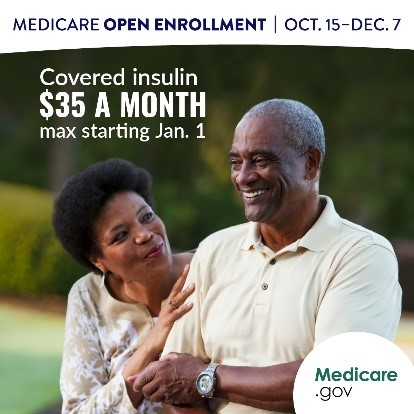
Thanks to the Inflation Reduction Act, beneficiary cost sharing for insulin will decrease in 2023. CMS estimates that this change will help at least 1.4 million Medicare beneficiaries. Timing of the decrease depends on whether the insulin is covered by Medicare Part D or Part B.
Part B generally covers traditional (that is, nondisposable) insulin pumps as part of the durable medical equipment (DME) benefit. If a beneficiary takes insulin through a Part B–covered traditional pump, Medicare Part B may also cover that insulin product. Unlike Part D, Part B does not cover insulin-related supplies, such as syringes, needles, alcohol swabs, and gauze. Part B coverage for insulin products in 2023 will change midyear, as stipulated by the IRA:
- From January 1 through June 30, coverage will remain identical to that of 2022. Beneficiaries must pay the Part B deductible before Medicare coverage of approved insulin products begins. After meeting the deductible, beneficiaries will pay 20 percent of the Medicare-approved amount for insulin products.
- Beginning on July 1, 2023, beneficiaries will pay no more than $35 for a one-month supply of Part B–covered insulin products. (Plans may charge less than $35 for a month’s supply.) If the beneficiary purchases a 60- or 90-day supply of a covered insulin product, they will pay no more than $35 for each month’s supply. As of July 1, Part B–covered insulin products will no longer be subject to the annual deductible.
Other Inflation Reduction Act–based improvements to Medicare coverage for prescription drugs will take effect in 2024 and subsequent years.
In addition to decreasing insulin cost sharing, the Inflation Reduction Act also improves access to vaccines for Medicare beneficiaries. Beginning on January 1, 2023, Medicare Part D enrollees will be able to obtain, with no OOP cost, adult vaccines recommended by the Advisory Committee on Immunization Practices with no OOP cost. These free vaccines include the shingles vaccine and the combined vaccine for tetanus, diphtheria, and pertussis (whooping cough), also known as “Tdap.” (Learn about Medicare coverage for other vaccines.)
Enrollment Tools
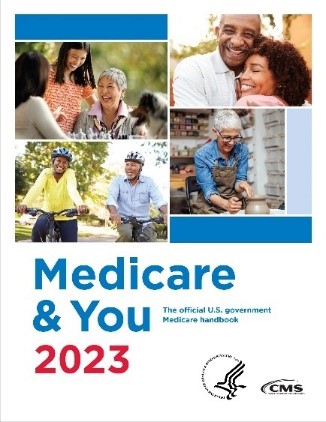
CMS sent a print copy of its Medicare & You 2023 handbook by postal mail to all Medicare beneficiaries in September. The handbook is available in the following languages and formats:
- English—standard print, large print, audio compact disc, podcast, Braille, and eBook
- Spanish—standard print, large print, audio compact disc, podcast, and Braille
- Chinese, Korean, and Vietnamese—standard print
Although Medicare & You is updated annually, it includes only basic information regarding Medigap, Part D, and MA plans. CMS encourages beneficiaries to use the handbook for quick comparisons and to seek more thorough information from other resources, as described below.
Live support from CMS is available 24 hours per day, seven days per week, except on some federal holidays. According to CMS, 10 a.m. to 4 p.m. EST are the busiest hours on any given day, and Mondays and Tuesdays are the busiest days of the week. CMS offers three options for live support:
- Telephone—Users who do not have internet access or who wish to talk with a CMS representative can call 1-800-MEDICARE (1-800-633-4227). CMS representatives can converse directly with beneficiaries in English and Spanish, and language line interpretation is available for more than 200 other languages.
-
Teletypewriter (TTY)—Users can call 1‑887-486-2048.
- Live chat—Users can initiate a live chat by clicking the chat icon in the top right corner of any Medicare.gov page, from the Contact Medicare page, or by going to Medicare.gov Live Chat.
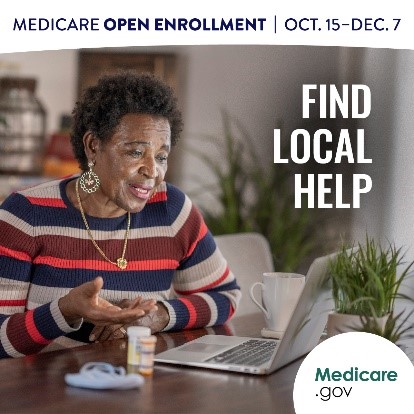
Another excellent resource for Medicare beneficiaries who need live assistance is the State Health Insurance Assistance Program (SHIP). SHIP can be especially helpful for the following people:
- beneficiaries with low literacy, including health and financial literacy
- beneficiaries with end-stage renal disease or other complex health conditions
- beneficiaries with a second type of coverage, including Medicaid
- beneficiaries with concerns about their Medicare rights
SHIP receives federal funding through the Administration for Community Living (ACL) (an administrative division of the U.S. Department of Health and Human Services) and provides free, one-on-one counseling and assistance with Medicare and other health insurance questions. Unlike private insurance brokers, SHIP counselors do not sell Medicare plans or receive commissions for enrollments. Therefore, SHIP is an unbiased, trustworthy source of information.
SHIP sites exist in all 50 states, the District of Columbia, Guam, Puerto Rico, and the U.S. Virgin Islands. Availability of virtual and in-person appointments varies based on location and beneficiary need. Appointments tend to fill quickly during the OEP, although SHIPs without available appointments may still be able to help beneficiaries by phone. To find a SHIP site in your state or jurisdiction, visit the SHIP Locator or call 1-877-839-2675.
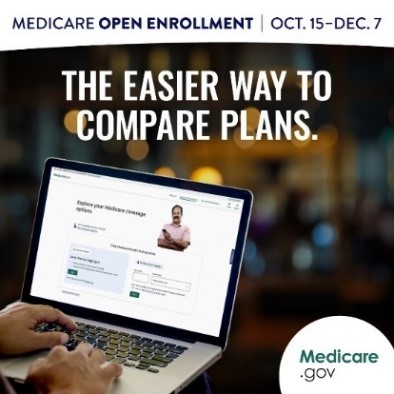 For users who have access to and are comfortable with digital technology, the Medicare Plan Finder (also known simply as “Plan Finder”) may be an appropriate tool for obtaining information about Medicare coverage options. Plan Finder is accessible by direct link or by clicking “Find health & drug plans” on the Medicare.gov home page.
For users who have access to and are comfortable with digital technology, the Medicare Plan Finder (also known simply as “Plan Finder”) may be an appropriate tool for obtaining information about Medicare coverage options. Plan Finder is accessible by direct link or by clicking “Find health & drug plans” on the Medicare.gov home page.
The “Plan Type” dropdown on the landing page of Plan Finder includes the option “I want to learn more about Medicare options before I see plans.” Users can either click this option or begin searching for one or more of the plan following types: Part D, Medigap, or MA. Details regarding navigation of each option follow.
- Part D—As in previous years, beneficiaries can compare and enroll in Part D plans on Plan Finder.
- Results for Part D plans available in a given area can be filtered by insurance carrier and star ratings and sorted in three ways: (1) lowest yearly drug deductible, (2) lowest drug + premium cost, and (3) lowest monthly premium.
- Users can refine search results by adding their prescription drugs alone, prescription drugs and preferred pharmacy, or neither.
- CMS encourages users to obtain comprehensive information on individual plans directly from insurance carriers. Beneficiaries can obtain insurance carrier contact information by clicking the “Plan Details” button for any given plan
- When a user is ready to enroll, they can do so through Plan Finder.
- Medigap—CMS has enhanced Plan Finder this year by adding Medigap pricing details to policy comparison.
- Results for Medigap plans available in a given area can be sorted by plan name (standardized type, “A–Z”) or monthly premium (low to high).
- For each plan (“A–Z”) offered, Plan Finder provides cost information for monthly premium (a dollar range), copays/coinsurance, and annual deductibles (Part A and Part B).
- Users can click on “Plan Details” to obtain additional information from CMS about any given plan name (type).
- Clicking on the “View Policies” button for any given plan name directs users to a list of policies offered by insurance companies in the user’s identified area.
- Results yield estimated cost ranges for monthly premiums and the insurance address, phone number, and website for each available policy.
- Results also specify the policy’s pricing tier: attained age pricing, in which premiums are low for younger enrollees and increase as the individual ages, or issue age pricing, in which premiums are low for younger enrollees and do not increase as the individual ages.
- Clicking on “get a more accurate price” at any point in the search process enables beneficiaries to add their age, sex (female or male), and tobacco use (yes or no).
- Beneficiaries cannot enroll in Medigap through Plan Finder, as they can in Part D. Instead, they must enroll directly through the insurance company’s website or by calling the company.
- MA—As in previous years, beneficiaries can compare and enroll in MA plans on Plan Finder.
- Users can refine search results by adding their prescription drugs alone, prescription drugs and preferred pharmacy, or neither.
- They can also select one or more MA plan type—Health Maintenance Organization (HMO), Preferred Provider Organization (PPO), or Medical Savings Account (MSA)—or search for all types of MA plans, including Private Fee-for-Service (PFFS) Plans.
- Results for MA plans available in a given area can be filtered by plan benefits, insurance carrier, drug coverage (included or excluded), star ratings, and Special Needs Plans (three types).
- Results can also be sorted in four ways: (1) lowest yearly drug deductible, (2) lowest health plan deductible, (3) lowest drug + premium cost, and (4) lowest monthly premium.
- As with Part D plans, CMS encourages users to obtain comprehensive information on MA plans directly from insurance carriers. Beneficiaries can obtain insurance carrier contact information by clicking the “Plan Details” button for any given plan.
- When a user is ready to enroll, they can do so through Plan Finder.
- PACE—Plan Finder includes a separate search tool for PACE plans. (Users can also find this tool by going to the Plan Finder landing page and clicking on the “Looking for PACE plans?” link in small type at the bottom left-hand side.) Searches yield only the name, identification number, and contact information for each plan. Beneficiaries cannot find details about or enroll in a PACE plan on Plan Finder; instead, they must visit the plan website.
Special Enrollment Considerations for Beneficiaries Who Use Insulin
During OEP training in September, CMS emphasized that plan selection and enrollment this year will be complex for beneficiaries who use insulin. Plan Finder does not include the $35 cap on insulin copayments because the IRA was signed into law after beneficiary cost sharing was updated for 2023. Consequently, ascertaining overall costs for beneficiaries who use insulin requires a multistep process during the current OEP.
Given this challenge, CMS recommends that all beneficiaries who use insulin seek enrollment assistance from their local SHIP site, if possible, or directly from Medicare (phone: 1-800-MEDICARE/1-800-633-4227; TTY: 1-887-486-2048). CMS does not recommend use of Medicare.gov Live Chat for beneficiaries who take insulin. Plan Finder will be updated with accurate insulin costs before the next OEP begins in October 2023.
Financial Assistance for Medicare Beneficiaries
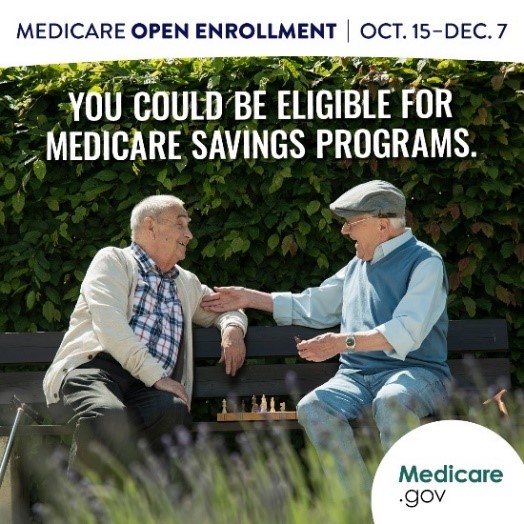
Various programs exist to assist beneficiaries who have limited income and resources. These programs are only available to beneficiaries who live in the District of Columbia or one of the 50 states. A description of publicly funded programs follows.
- Medicare Savings Programs (Medicare Savings Programs (MSPs)—These Medicaid-administered programs help Medicare beneficiaries pay for OOP costs associated with Part A and Part B. Depending on the program—Qualified Medicare Beneficiary (QMB), Specified Low-Income Medicare Beneficiary (SLMB), Qualifying Individual (QI), or Qualified Disabled Working Individual (QDWI)—the plan may cover premiums, deductibles, copayments, coinsurance, or some combination of these. CMS’s MSP page provides details about eligibility and benefits for each program. Three entities offer free screening for MSP eligibility and can assist beneficiaries in applying for an MSP:
- Medicaid offices
- SHIP sites
- Benefits Enrollment Centers (BECs)—Supported by the National Council on Aging and funded, in part, by ACL, 85 BECs are spread across 41 states. Moreover, the National Council on Aging’s BenefitsCheckUp®, also funded in part by ACL, is a free online tool to help beneficiaries determine their eligibility for MSPs and other public programs.
- Extra Help, also known as “Low Income Subsidy” (LIS)—This program, administered by the Social Security Administration (SSA) in coordination with CMS, helps cover Part D premiums, deductibles, copayments, or some combination of these OOP costs. Extra Help eligibility criteria for 2023 are listed in Section 7 (“Get help paying your health & drug costs”) of the Medicare & You handbookhandbook.
Medicare beneficiaries are automatically screened for Extra Help
eligibility if they receive Supplemental Security Income or are enrolled
in an MSP or Medicaid. Other beneficiaries may contact
SSA, their local SHIP, or a BEC
in their state to determine if they are eligible and to obtain
assistance in applying for Extra Help. Beneficiaries may also check
their eligibility for Extra Help by using
BenefitsCheckUp®.
- State Pharmaceutical Assistance Programs (SPAPs)—As of 2020, SPAPs were available in 15 states and the U.S. Virgin Islands. SHIP sites maintain information regarding current availability. Assistance varies among SPAPs. (It is worth noting that some pharmaceutical companies offer their own private assistance programs, which are distinct from SPAPs. Plan Finder includes a specific search tool for such programs.)
Unfortunately, many publicly funded programs are severely underutilized by older adults; MSP enrollment among eligible Medicare beneficiaries of all ages is particularly low. NASW recently submitted comments to CMS affirming a proposed rule to streamline eligibility determination for and enrollment in MSPs; the association will update social workers when CMS publishes the final rule.
Messaging Regarding MA and Original Medicare
NASW’s prior OEP blog, published in November 2021, noted that the 2022 edition of Medicare & You had incorporated significant changes that provide a more balanced approach to the distinctions between original Medicare and MA. Such changes were critical following unprecedented bias toward MA during the Trump Administration. A recent analysis by the Center for Medicare Advocacy observed additional improvements in the 2023 edition, particularly in regard to prior authorization, out-of-pocket costs, and extra (or supplemental) benefits. The analysis concluded:
Along with the improvements made to last year’s version, we are encouraged by the edits to the 2023 Medicare & You Handbook. We hope this return to objectivity and trend away from bias in favor of Medicare Advantage continues in other Medicare outreach and enrollment materials. More broadly, we hope both Congress and CMS will work to address the growing imbalance between traditional Medicare and Medicare Advantage, and work to improve the Medicare program for all of its enrollees, not just those who choose, or are automatically enrolled, in private plans. (pp. 5–6; hyperlink included in original text)
NASW concurs with this analysis and affirms the Biden–Harris Administration’s ongoing efforts to reverse the prior bias toward MA. In August, the association submitted detailed comments to CMS in response to a request for information regarding MA. Beginning with the assertionthat “barriers [to care] tend to be greater for enrollees in MA plans, … particularly for individuals who have serious illnesses or live with chronic conditions,” (p. 1), NASW recommended strategies regarding the following topics:
- advancing equity within MA, particularly in regard to beneficiaries with significant health conditions
- promoting informed decision making among beneficiaries regarding Medicare coverage options (including expanding Medigap guaranteed issue rights and increasing federal funding for SHIP, 1-800-MEDICARE, and SMP)
- increasing oversight of and decreasing broker compensation for MA marketing
- strengthening network adequacy requirements
- overhauling MA star ratings
- promoting payment parity between MA and original Medicare by reversing long-standing overpayments to MA plan sponsors
NASW’s 2019 OEP Practice Alert described in detail the association’s longtime advocacy to address these concerns. For additional information regarding MA-focused policy advocacy,please refer to the Center for Medicare Advocacy’s recent Call to Action—Policy Makers Must Increase Medicare Advantage Oversight and Rein in Overpayments.
As noted previously within this Practice Alert, Medicare beneficiaries may obtain unbiased information regarding Medicare coverage options from their local SHIP. Social workers and beneficiaries seeking accurate information about Medicare coverage options may also find the following free resources useful:
Additional Materials from CMS
Learn more about Medicare open enrollment and Medicare changes for 2023 by accessing these free CMS materials:
Use CMS’s consumer-friendly educational and outreach materials in your work with clients:
- English—written materials, videos, TV and radio ads, and social media; 20-minute video about how to use Plan Finder, step by step
- Spanish—written materials, videos, radio ads, and social media
- Materials for other audiences—several English-language materials for American Indian and Alaska natives; Medicare open enrollment fact sheets and flyers in Arabic, Chinese, Creole, Khmer, Korean, Polish, Russian, and Vietnamese
Prepared by Chris Herman, MSW, LICSW (she/her)
Senior Practice Associate–Aging